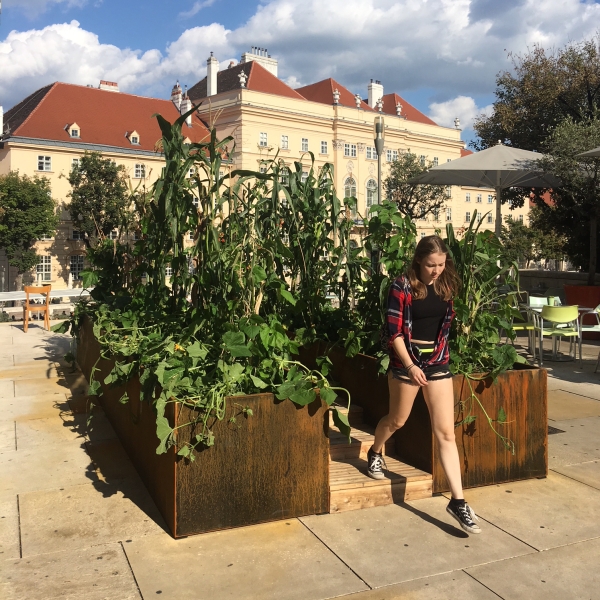
Installation View: September 2017
Installation View: January 2018
Passing through Three Sisters Corridor, 2017
Invitation for Thanksgiving Dinner, 2017
Thanksgiving Dinner, 2017
Drei Schwestern Korridor
Museum Moderner Kunst Stiftung Ludwig Wien
Natural Histories, Traces of The Political
23.September 2017 bis 14. Januar 2018
Summer: Indian corn, bean, and pumpkin plants, soil, walkway in larch, 2 steel tanks, 600 × 90 × 80 cm each
Winter: Cover in pine
Christian Philipp Müller employs extensive research to track down historical traces in everyday themes and objects. He probes not only the history of art and culture but also sociology, politics, ecology and the economy. His role is that of a researcher and historian whose universal interest makes it possible to visualize history in the form of contemporary art. He searches for aesthetic and formal strategies whose at times rapturous and poetic moments aim to involve the viewer.
One recurring theme of his research is the garden. The departure point for his Drei-Schwestern-Korridor (Three Sisters Corridor), specially conceived for mumok, is the historical transfer of crops from South American countries to the “Old World” in the course of conquest, missionary work, and economic exploitation. In Mayan agriculture the “three sisters”—corn, beans, and pumpkins—as intercropping formed a symbiosis, which represented a highly developed ecological system of cultivation, named Milpa, through reciprocal climbing support, the exchange of nutrients, and protection from soil erosion. The various phases of planting and harvesting were accompanied by shamanistic rituals, which also anchored the system of growing in the Mayan’s cosmic world view.
Müller’s installation of two long raised beds provides access via a small threshold, a kind of walkway. In the urban setting of the MuseumQuartier, the processual approach to the museum as a locus of cultural production is combined with an experience of nature, one which represents an (almost) lost cultural achievement. In 2006 in the garden of the Benedictine Melk Abbey, Müller realized a similar work with Die Neue Welt (The New World). There installed on an island in a body of water, akin to an inaccessible landscape of longing, was his year-round garden comprising a variety of ancient South American plant species. Here before the prosaic urban backdrop, the garden is imminent and corporeal, and via the steps visitors can make their way onto the same level as the plants. Whereas the form of the installation in front of mumok references the location in concreto, the choice itself of the plants is down to the timing of the exhibition; corn, beans, and pumpkins are harvested in the fall, and part of the installation is their ripening, wilting, and consumption for American Thanksgiving. According to the myth
the Pilgrim Fathers celebrated a three-day harvest festival together with the indigenous Wampanoag Native Americans. Back then, as today, a transfer of cultures took place during the communal feast, an act of social communication that is directly associated with a sensory physical experience. The installation, the film accompanying the exhibition, and the books presented there on the art of horticulture from the library of Melk Abbey are a reminder that we are constantly literally imbibing foreign cultures in the form of diverse crops.
//
Christian Philipp Müller verfolgt in ausgiebigen Recherchen historische Spuren in Themen und Objekten des Alltags. Dafür dringt er nicht nur in die Kunst- und Kulturgeschichte vor, sondern auch in Soziologie, Politik, Ökologie oder Ökonomie. Seine Rolle ist die eines Forschers und Historikers, dessen universalistischer Anspruch eine Vergegenwärtigung von Geschichte in Form aktueller Kunst ermöglicht. Dabei sucht er nach ästhetischen und formalen Strategien, deren manchmal auch lustvollen und poetischen Momente auf eine Miteinbeziehung der Betrachter_innen abzielen.
Der Garten ist ein wiederkehrendes Thema seiner Forschungen. Ausgangspunkt für den Drei-Schwestern-Korridor, der speziell für das mumok konzipiert wurde, ist der historische Transfer von Kulturpflanzen aus den Ländern Südamerikas in die Alte Welt im Zuge von Eroberung, Missionierung und wirtschaftlicher Ausbeutung. In der Landwirtschaft der Maya bildeten die „drei Schwestern“ Mais, Bohnen und Kürbis als Mischkultur eine Symbiose, die durch Rankhilfe, Nährstoffaustausch und Erosionsschutz ein ökologisch hoch entwickeltes Anbausystem, genannt Milpa, darstellte. Schamanistische Rituale begleiteten die verschiedenen Phasen von der Pflanzung bis zur Ernte und verankerten diese Anbauweise in der kosmologischen Weltsicht der Maya.
Müllers Installation aus zwei langen Hochbeeten ermöglicht den Durchgang über eine kleine Schwelle, eine Art Laufsteg. In der städtischen Situation des MuseumsQuartiers wird die Annäherung an das Museum als Ort der Kulturproduktion so mit einer Naturerfahrung verbunden, die durch eine (fast) verlorene Kulturleistung ermöglicht wird. Im Garten des Benediktinerklosters Melk hat Müller 2006 mit Die Neue Welt eine ähnliche Arbeit realisiert: Dort besteht sein ganzjähriger Garten aus einer Vielzahl alter südamerikanischer Pflanzensorten und ist auf einer Insel in einem Wasserbecken installiert, einer unerreichbaren Sehnsuchtslandschaft gleich. Hier, vor der nüchternen Stadtkulisse, ist der Garten nah und greifbar, über die Stufen können sich die Besucher_innen auf das Niveau der Pflanzen begeben. Bezieht sich die Form der Anlage vor dem mumok auf den konkreten Ort, ist die Auswahl der Pflanzen der Zeit der Ausstellung geschuldet: Mais (Zea mays), Bohnen (Phaseolus vulgaris) und Kürbis (Cucurbita pepo) werden im Herbst geerntet. Teil der Installation ist ihr Reifen, Verwelken und Verspeisen zum amerikanischen Thanksgiving. Dem Gründungsmythos zufolge feierten die Pilgerväter zusammen mit den einheimischen Wampanoag-Indianern ein dreitägiges Erntedankfest. Im gemeinsamen Mahl manifestiert sich damals wie heute ein Kulturtransfer, ein Akt sozialer Kommunikation, der unmittelbar an sinnlich-körperliches Erleben gebunden ist. Die Installation, der begleitende Film in der Ausstellung und die dort präsentierten Bücher zur Gartenbaukunst aus der Stiftsbibliothek Melk erinnern daran, dass wir uns in Form der diversen Früchte immer wieder fremde Kultur buchstäblich einverleiben.




